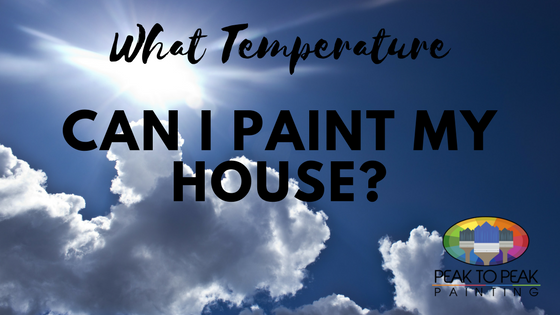What Temperature Can I Paint My House?
Painting a house can be a daunting task in and of itself. Deciding on what colors to paint and obtaining the correct materials to splash on a new color on the outside of your house are just the beginning steps though. An important aspect to consider when you decide to paint your house is the weather, which, for the most part, is out of your control. For those of us who live in Durango, you know the temperature can change dramatically in a matter of minutes! However, when you factor in the weather, you will be able to predict the best time to undertake your painting endeavor.

Best Time and Temperature to Paint
Depending on the type of paint you have purchased, the temperature requirements can vary, which makes it important to read the manufacturer’s specifications for the paint you will be using. Typically, when using an oil-based paint, there is a wide range of temperatures at which it would be appropriate to paint outside. The rule of thumb when using this type of paint is to apply it when the outdoor temperature is between 40 and 90 degrees, which allows for the application to be completed during the majority of the year in most geographical locations (Janeway, 2017). When temperatures dip below this recommended range, it can make the paint quite thick, with some brands or formulas turning into a semi-solid state during cold weather (Rodriguez, 2016).
While the temperature may be right during the application period, but the curing period during which the paint will be drying also has to be above a certain temperature to ensure that the paint dries and cures sufficiently. An ineffective curing period can lead to a decrease in the durability, as well as inviting the growth of mildew and stains on your newly painted exterior (Janeway, 2017). It is recommended that the temperature not drop below freezing during the curing period, which may take upwards of a few days. As such, it is important to pair your outdoor painting projects with the weather forecast to ensure that the application and curing times are not hindered by cooler evening weather.
However, cold temperatures are not the only thing to look out for when deciding when to paint the exterior of your house, as the heat can also affect the ability for the paint to be applied and can influence the quality of the curing stage. When the mercury exceeds the 90 degree mark, outdoor painting is not recommended, particularly since the surface of the exterior of your house will most likely be warmer than the ambient air (Consumer Reports, 2016). Painting during times where the temperature is above 90 degrees, it can affect the drying time of the paint, leading it to dry too fast. When paint dries too fast, the application process may not come out even and you may notice brush marks, two things that you do not want to happen when you paint the exterior of your house (Consumer Reports, 2016).
Hacks for When the Time Is Not Right
While there are industry standards that are set for the temperatures, during which application is ideal, the weather may not always follow the forecast. In these instances, there are a few tricks of the trade that you can use when the temperature is not cooperating with your outdoor painting plans. For instance, if you are using a latex-based paint, there are additives available to reduce the thickening effect that cold weather has on this type of outdoor paint (Rodriguez, 2016). It is also a good idea to turn the heat up inside so that the exterior walls can warm up, allowing your paint to dry faster. Additionally, if you need to paint outside in less than desirable temperatures, try to paint between 10am and 2pm, when there is minimal wind present. You will also need to extend the time between coats of paint, as cooler weather can hinder the curing and drying processes (Rodriguez, 2016). Another good idea is to use scaffolding to drape tarps over, which allows the section you are working on to be out of the elements, and with the addition of an outdoor source of heat, it can help to increase the temperature of the surface and ambient air, leading to better paint coverage and drying.
Can I Use Interior Paint to Paint the Exterior of My House?
In a word, no. Interior and exterior paints have different formulations to withstand the environment in which they are intended to be used. While all paint contains resins, color pigments, additives, and solvents, there are some stark differences between the ingredients in exterior and interior paints (Primetime Paint & Paper, 2013). Exterior paint is also designed to be more durable, resisting fading, peeling, and chipping, which you may experience if you were to use an interior paint to paint the outside of your home.
Conclusion
Painting the exterior of your home can improve the value and resale of your home. However, the quality of your paint job can greatly influence the added value associated with a new coat of paint. Variables such as weather, humidity, and the type of paint you use can affect the outcome of your project. As such, it is recommended to read the manufacturer’s instructions as they pertain to the ideal temperatures for your specific product. If you are in doubt, you can always contact a professional to assess the conditions and, if necessary, assist you in your painting endeavors.
References
Consumer Reports. (2016). What is the best temperature to paint outside? Retrieved from http://www.consumerreports.org/exterior-paints/how-warm-is-too-warm-to-paint-my-house/
Janeway, K. (2017). How cold is too cold to paint outside? Retrieved from http://www.consumerreports.org/exterior-paints/how-cold-is-too-cold-to-paint-outside/
Primetime Paint & Paper. (2013). What’s the difference between interior and exterior paints? Retrieved from http://primetimepaint.ca/2013/whats-the-difference-between-interior-and-exterior-paints/
Rodriguez, J. (2016). Professional tips on cold weather painting. Retrieved from http://www.thebalance.com/professional-tips-on-cold-weather-painting-844925